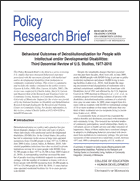Download PDF (492 KB, 12 pp.) To view a PDF file, you'll need Adobe Acrobat Reader on your comp uter. Acrobat Reader may be downloaded from the Adobe Web site
Text Only Version (below)

Published by the Research and Training Center on Community Living, Institute on Community Integration • College of Education and Human Development, University of Minnesota
Volume 21 • Number 2 • April 2011
Behavioral Outcomes of Deinstitutionalization for People with Intellectual and/or Developmental Disabilities: Third Decennial Review of U.S. Studies, 1977-2010
This Policy Research Brief is the third in a series reviewing U.S. studies that have measured behavioral outcomes associated with the movement of people with intellectual and/or developmental disabilities from institutions to community residential settings. This review is cumulative and includes the studies contained in the earlier reviews (Larson & Lakin, 1989; Kim, Larson, & Lakin, 2001). The review was conducted by Charlie Lakin, Sheryl A. Larson, and Shannon Kim of the Research and Training Center on Community Living, Institute on Community Integration, University of Minnesota. Support for the review was provided by the National Institute on Disability and Rehabilitation Research through funding for the Research and Training Center on Community Living. For further information on this review, contact Charlie Lakin at (612) 624-6328 or lakin001@umn.edu.
Introduction
Deinstitutionalization as a policy and a practice has produced dramatic changes in the sizes and types of places where individuals with intellectual and/or developmental disabilities (ID/DD) live. In the United States, this policy has led to reductions in the census at large state-operated institutions from 154,600 people in June 1977 to 32,900 in June 2009 (Lakin, Larson, Salmi, & Webster, 2010). Substantial population reductions have also occurred in private institutions serving 16 or more people with ID/DD, from 52,700 people in June 1977 to 26,700 in June 2009 (Lakin et al., 2010). A corresponding trend has increased the number of people receiving residential supports in community settings, with the number of residents in homes with six or fewer people with ID/DD increasing from 20,400 people in 1977 to 321,500 people in 2010. By 2010, 11 states had no state-operated residential facilities for 16 or more persons with ID/DD.
Despite the remarkable changes that have occurred over the past three decades, there were still, in June 2009, nearly 60,000 people with ID/DD living in private or public residential institutions and almost 30,000 living in nursing facilities (Lakin et al., 2010). And despite the ongoing movement toward depopulation of institutions and a national commitment, established in the Americans with Disabilities Act of 1991 and affirmed by the U.S. Supreme Court in its 1999 decision in Olmsted et al. v. L.C. et al., to continue progress toward ending isolation of persons with disabilities, deinstitutionalization continues at a relatively slow pace in some states. In 2009, states ranged from five states with no residents with ID/DD in institutional settings of 16 or more residents to four states with more than one-third of their residential service recipients living in institutions (Lakin et al., 2010).
A considerable body of research has examined the relative benefits and detriments associated with institutional and community living. This research has included studies of community participation, social relationships, family involvement, access to health services and other outcomes of importance. Many of these studies have examined changes in adaptive or challenging behavior associated with movement from institutions to community settings. Our previous summaries of this research have noted that, overall, between 1977 and 1999 a substantial majority of U.S. studies of adaptive behavior (daily living skills) found relative benefits accruing with movement to community settings from institutions. This Policy Research Brief updates our earlier review by including studies conducted between 2000-2010. It reviews research studies of changes in adaptive behavior, that is changes in basic skills of independent daily life, associated with movement from institutional to community residences. It also reviews the changes in challenging (problem) behavior among the people involved in studies of adaptive behavior change. It is understood in presenting the findings of this analysis that adaptive behavior and challenging behavior are only two of many important outcomes of residential services. However, considering the continuing debates and varying commitments among states regarding depopulation and closure of institutions, and the substantial investments made in efforts to increase the independence of persons with ID/DD wherever they live, these studies have high relevance to national and state policy.
Methodology
Selection of Studies
This review includes studies identified through the following methods: (a) a computer search of the PSYCHINFO and ERIC databases from 1977 to 2010; (b) a manual review of American Journal on Intellectual and Developmental Disability, Education and Training in Developmental Disabilities, Research and Practice in Persons with Severe Disabilities, Journal of Intellectual and Developmental Disabilities, and Intellectual and Developmental Disabilities from 1977 to 2010; (c) use of the “ancestry approach” of manual review of reference lists of relevant research to locate additional studies; (d) direct requests for assistance in identifying relevant studies made to researchers prominent in this area of research; and (e) Web-based searches using Google search engine and key words related to the topic.
In our search for relevant research over the past three decades, 265 studies have been screened for inclusion in this review. The following criteria were applied in selecting studies for inclusion: (a) studies included persons in U.S. institutions; (b) studies conducted in 1975 or later and published in 1977 or later; (c) a minimum of five subjects moved from institutional to community residences; (d) basic demographic information reported about the sample; (e) exclusive or primary use of adult subjects; (f) baseline data collected while the subjects were residing at the institution or within the month they moved to the community; (g) post-test results obtained after the subjects had resided in the community a minimum of six months; and (h) overall adaptive behavior, overall challenging behavior, and/or specific domains of adaptive or challenging behavior were measured with the same assessment instruments in the same manner at the times being compared. The authors conferred in applying the criteria to specific studies. These methods yielded a total of 45 individual studies eligible for inclusion in this summary. Three types of research design were identified: longitudinal designs, which examined changes for a single group of subjects over time (31 studies); contrast group designs, which compared changes in treatment (leavers) and contrast groups (stayers) over time (17 studies); and studies that used both types of design (3 studies).
Coding Procedures
The 45 separate studies were reviewed and coded by the authors according to research design, outcomes reported, and direction and magnitude of the findings. Several different types of outcomes were reviewed and coded. Adaptive behavior outcomes were summarized into eight categories: overall adaptive behavior, and seven sub- domains, including academic skills, community living skills, language/communication skills, motor/physical skills, self-care/domestic skills, social skills, and vocational skills. Challenging behavior outcomes were summarized in the three most frequently cited categories: overall challenging behavior, externally focused behavior (e.g. aggression, property damage), and internally focused behavior (e.g. withdrawal, self-injury).
One of the primary challenges in summarizing the studies was the differences in the outcome data provided. Most studies included descriptive statistics and appropriate tests of statistical significance, but not all. Most studies did not include sufficient statistical data to allow computation of an index of statistical significance (a Delta statistic). Such computations are often useful in social research because typically such studies have substantial variation findings. Such was not the case, however, in the studies included in this review. Computation of a single numerical index was not an option for this review nor is it one that is universally recommended (Pillemer & Light, 1984). Summarizing the effect sizes of the various studies was also impeded by variations in the data presentations.
To allow comparison of all studies a procedure was created for coding the direction and magnitude of outcomes with the baseline (institutional) scores or contrast group scores as the point of reference:
- A “+” was recorded to indicate the community sample scores increased in comparison with the baseline or the contrast group, but not to a statistically significant (or in some cases statistically tested) degree.
- A “+ +” was used to indicate that the magnitude of the difference was statistically significant (p ≤ .05).
- Likewise, a “–” was used to indicate scores were less than baseline or the contrast group following the move to the community.
- A “– –” was used to indicate the lower score was statistically significant (p ≤ .05). In cases in which the authors did not test for statistical significance, a “+” or “–” was recorded depending on the direction of the comparison.
- A zero “0” was used to signify that no tendency was found or that a difference was reported as “not significant” with no indication of direction of the changes within the report.
In summarizing the findings, blanks were used to indicate a category of outcome was not studied, or that no data were reported. Footnotes are provided as needed to clarify various aspects of a study’s summary.
The decision rules were developed and consulted to resolve potentially conflicting findings. Conflicting findings were apparent when studies reported findings from more than one measure in a single domain. These were coded as follows:
- When such findings were in opposite directions, a “0” was recorded to indicate that the findings appeared to cancel each other out and/or that the results could not be interpreted.
- When the findings were in the same direction, but of different magnitudes (i.e., “+ +”, “+” or “– –”, “–”), they were reported to be not statistically significant (i.e., “+” or “–”).
- When studies used multiple baselines, the last baseline score obtained while the subjects resided in the institution was used as the point of reference.
- When studies reported results for the same group for more than one pre-test to post-test period, the outcome for the longest interval between baseline and follow-up was recorded.
- If the length of follow-up varied among the sample members, the “time” in months of the follow-up is reported as a range.
Results
Contrast Group Studies
Contrast group studies compared the outcomes for people who moved from institutions to community residential settings with those of a “contrast” group of people who stayed in institutions. It should be noted that contrast group studies can show positive results for the treatment or contrast group even in the absence of their own positive change if the group to which it is compared decreases in the outcome being measured.
General Adaptive and Challenging Behavior
As shown in Table 1, there were 11 of the contrast group comparisons identified. These included one study (Spreat & Conroy, 2001) in which a treatment group of people moving from a single closed state facility was compared with two different comparison groups from two separate public facilities that remained open. All of the 11 contrast group studies found either statistically significant better outcomes in overall adaptive behavior associated with community placement (7) or found benefits that did not reach statistical significance (4).
In terms of overall challenging behavior, only one of five studies reported a difference between stayers and leavers that was statistically significant. In that study, challenging behavior of the movers remained the same, while stayers had overall challenging behavior ratings that declined significantly. The remaining four studies were evenly divided (two each) in showing non-significant better outcomes for movers and stayers.
| Table 1: Overall Adaptive and Challenging Behavior Outcomes: Contrast Group Studies |
|---|
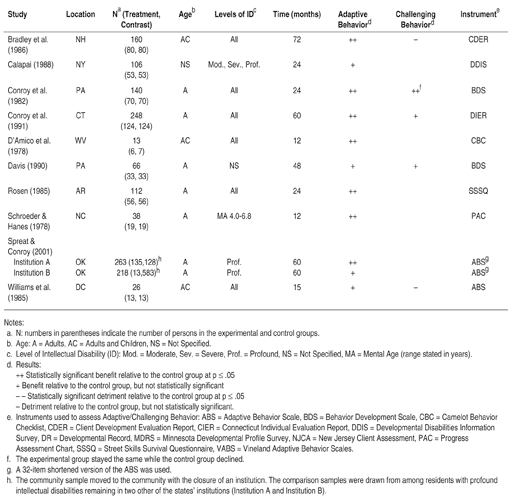 |
Domains of Adaptive and Challenging Behavior
There were 10 studies of matched groups of people leaving and remaining in institutional settings that examined outcomes in one or more of seven adaptive/daily living skill domains and/or one or both of two challenging behavior domains. Table 2 shows the results. In all, 41 comparisons were made. In all but five of the comparisons, movers had either statistically significant better outcomes than contrast group members, or better outcomes that did not reach statistical significance. The five comparisons that did not favor the movers reported no difference. The self-care/domestic skills domain of adaptive behavior showed the most consistent statistically significant benefits. Other adaptive behavior domains that showed statistically significant better outcomes for movers in at least half of the comparisons with no contradictory negative outcomes included academic skills, community living skills, and social skills. Unlike the overall challenging behavior findings, which showed little consistency in differences between stayers and movers, externalized challenging behavior (e.g., aggression toward other people and property destruction) was significantly better for movers in both studies making the comparison.
Longitudinal Studies
Longitudinal studies differ from contrast group studies in that the comparison is not being made with another comparable group, but with the same group of individuals over time. For longitudinal studies to show benefit from a move to the community, movers must have improved outcomes, whereas, again, contrast group moving or staying can be determined to be beneficial for a group based on decreases in the outcome measures.
| Table 2: Adaptive and Challenging Behavior Domain Outcomes: Contrast Group Studies |
|---|
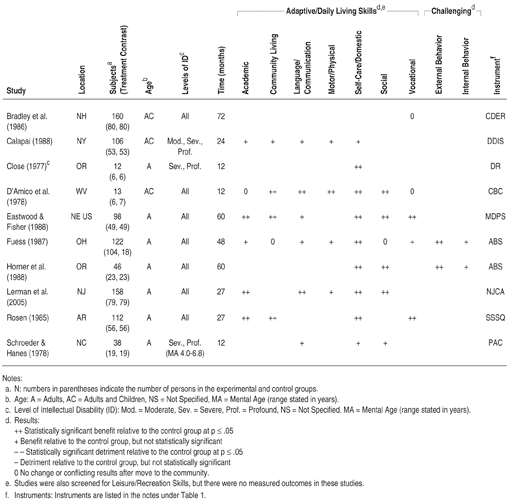 |
General Adaptive Behavior
A total of 25 U.S. longitudinal studies examined changes in overall adaptive behavior among movers. These are summarized in Table 3. Fifteen of the studies reported statistically significant improvements in overall adaptive behavior associated with moving to a community setting. Five other studies reported improvements that were not statistically significant, or that were not tested for significance. Three studies reported a statistically significant decline in adaptive behavior for people who moved from institutions to community settings and two studies reported decreases that were not statistically significant.
General Challenging Behavior
There were 21 longitudinal studies of changes in challenging behavior following movement to community settings (see Table 3). They showed the same variability reported for the contrast group studies. Eleven of these U.S. studies found improvements in challenging behavior after the move, including four studies in which these changes were statistically significant. In contrast, eight studies reported increased levels of challenging behavior after the move, including three studies that reported statistically significant increases. Two studies found no difference.
| Table 3: Overall Adaptive and Challenging Behavior Outcomes: Longitudinal Studies |
|---|
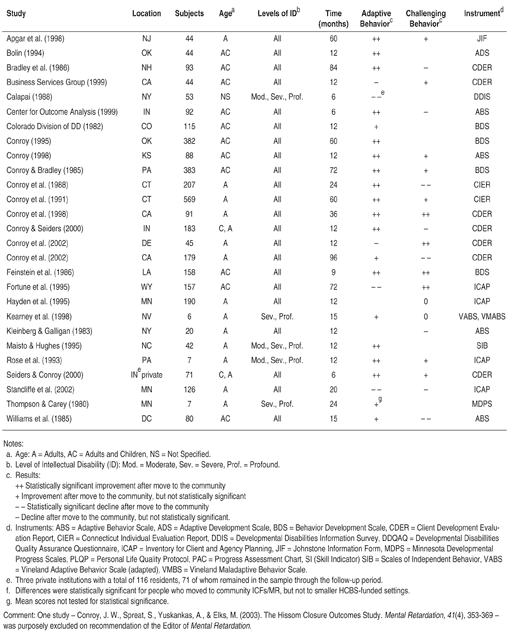 |
Domains of Adaptive and Challenging Behavior
Thirteen longitudinal studies examined changes in specific domains of adaptive and challenging behavior (See Table 4). While the contrast group studies found that the most consistent patterns of benefit from moving from institutions to community were in self-care and domestic skills, among the longitudinal studies social skills were the area of most consistent improvement. Five of the six longitudinal studies that measured social skills found statistically significant improvements after movement to the community, and the one found improvements that did not reach statistical significance. Consistent improvements were reported for community living skills in which four of five studies found statistically significant improvements and one found improvement not reaching statistical significance.
| Table 4: Adaptive and Challenging Behavior Domain Outcomes: Longitudinal Studies |
|---|
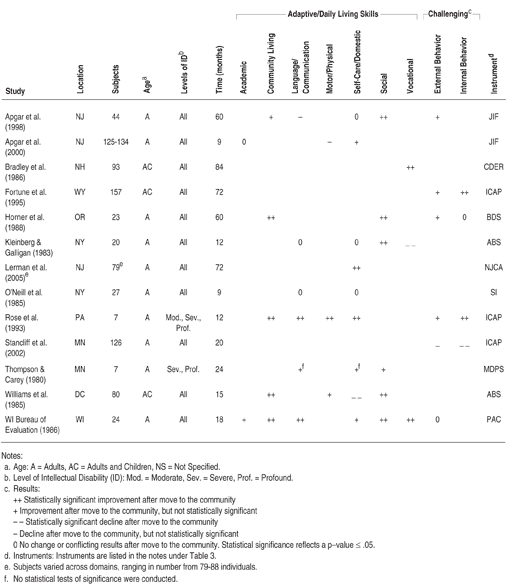 |
Summary of Studies in Specific Areas
Altogether there were 21 studies that examined the relative benefits of moving from institutions to community settings in specific areas of daily living. These studies included 10 studies of the outcomes for movers compared with those of matched stayers. They included 11 studies that followed the same individuals from institutional living to 9 to 84 months of community living. At total of 75 comparisons were made in the seven areas of daily living shown in Tables 2 and 4. Of these, 64 (85%) indicated benefits of the move to the community, 4 (5%) indicated detriment in skill development associated with the move, and 7 (10%) indicated no difference.
Patterns within specific domains of challenging behavior were not predictably associated with movement to the community. Two studies reported significant improvements in internal maladaptive behavior (e.g., withdrawal, self-injurious behavior), but another study found statistically significant deterioration. Among the studies of externalized challenging behavior, four of six studies found improvements, but none of the differences reached statistical significance. Two studies found deterioration that was not statistically significant and one found no difference.
Discussion
This is the third summary of studies of the association between moving from institutions with 16 or more residents to smaller community settings and the adaptive and challenging behavior of persons with ID/DD in the U.S. Twenty years ago, when we completed our first summary of the literature on these same outcomes of deinstitutionalization, we concluded that “available research denies support for the assertion that people obtain greater or even equal benefit in adaptive behavior from living in institutions. In fact, this research suggests that those benefits very consistently accrue more to the people who leave institutions to live in small community homes” (Larson & Lakin, 1989, p. 330). The studies that have been completed in the subsequent two decades only strengthen this conclusion.
With regard to adaptive behavior there remains highly consistent evidence of benefits accruing to people with ID/DD from movement from institutions to community. Of 11 treatment/comparison group studies, 7 found individuals in the deinstitutionalized sample with statistically significant more positive change in adaptive behavior than the comparison group; and the remaining 4 also found the movers with greater positive changes, although not to a statistically significant degree. Of 26 longitudinal studies of changes in adaptive behavior of individuals leaving institutions for community living, 15 reported statistically significant positive changes, 5 others reported positive but not statistically significant change. In contrast to the 31 studies showing increased general adaptive behavior following moving from institutions, there were only 5 that found decreases in adaptive behavior, including 3 that found statistically significant decreases.
There were seven areas of daily living skills in which a minimum of six studies provided either comparisons between movers and comparison group members or longitudinal assessment of outcomes associated with movement to the community: academic skills, community living skills, language/communication skills, motor/physical skills, self-care/domestic skills, social skills, and vocational skills. As shown in Tables 2 and 4 there were consistent findings of benefit in moving to the community. In the area of self-care/domestic skills, 13 of 16 studies found people moving to the community advantaged by the move. In the area of community living skills, 9 of 10 studies reported positive difference associated with the move. In the area of social skills, 10 of 11 studies reported positive difference associated with community living (one with no difference reported). All together 85% of 75 comparisons made in the seven most frequently studied areas of daily living skills showed benefits of community living; four (5%) found detriments.
In the analyses of challenging behavior, the reviewed studies found much less consistency in outcomes associated with moving to the community. In the area of general challenging behavior, of 26 comparison group and longitudinal studies reviewed, 14 found positive outcomes associated with the move to the community, but only 5 were statistically significant. There were 10 studies that found negative outcomes, with only 3 findings statistically significant. Two studies reported no difference. With regard to the domains of externalized challenging behavior (e.g., aggression, property destruction) and internalized challenging behavior (e.g., withdrawal, self-abuse), patterns remained inconsistent. Of eight studies that included analysis of change in externalized challenging behavior, six reported reductions following the move, but in only two of the studies were the differences significantly significant. Seven studies examined changes with internalized challenging behavior with four of these reporting benefits of the move; only two with statistically significance. Two studies reported detriment associated with the move, one with statistical significance. One study reported no difference.
The studies reviewed here provide strong and consistent evidence that people who move from institutions to community settings have experiences that help them to improve their adaptive behavior skills. The studies also suggest, however, that community placement alone is not a consistently effective means of reducing challenging behavior. But even the finding of no consistently better outcome in challenging behavior with movement to community settings challenges the assertion that institutional settings are needed (i.e., are beneficial for) people with challenging behavior.
This review has been able to draw on a data set of remarkable size (45 studies with about 5,000 subjects total). The studies also provide important opportunities to observe actual developmental change over periods of six months to seven years. The consistency of the findings is not easily dismissed. There are, however, limitations that must be noted:
- While more than 260 studies were reviewed to identify the 45 studies that met all criteria on this topic, there may be other studies that were not identified by the methods we employed. Although multiple approaches were used to identify relevant studies, much of this research is contracted by government agencies and is not submitted for publication. Its identification, therefore, may not always have been successful.
- Much of the research review is longitudinal and there may have been maturation effects. As people get older they tend to grow and develop skills. In a longitudinal study, people are getting older during the study. The selection criteria attempted to control for this by ruling out studies conducted primarily on children who are most susceptible to “maturation effects.” The congruence between the findings of the contrast group and longitudinal studies suggest that the outcomes noted were not due solely to maturation effects. Indeed, the mover groups’ benefits over the comparison groups of stayers were in certain instances due to decreases in adaptive behavior among the latter. In general the contrast studies which provide the best means to control for any potential maturation effects tended to find more consistent benefits of moving from institutional settings than did the longitudinal studies.
- Many studies adapted existing instruments to meet their own purposes. While most studies reviewed reported the reliability and validity of their measures or used measures with reliability reported elsewhere, not all did. No differences were noted in outcomes in studies using tested and non-tested instruments.
- While all of the studies met basic criteria listed in the methods section, studies varied in their rigor or at least in the degree to which the rigor of their methodology was described, and/or fidelity to the methodology was assessed. Studies also varied in the extent to which interviewers were trained and observed to meet criteria prior to conducting interviews.
- The subject pool for the studies may have a positive bias in that some persons who moved to the community were later re-institutionalized and therefore lost to the samples. Although the behavior assessments for persons re-institutionalized before follow-up were not included in the data sets, these persons may have been ones who would have exhibited relatively less benefit from the community placement.
- Interview respondents in the institutional and community settings were not the same individuals, and although the scales of adaptive and challenging behavior are made up of items of relatively objective observable behavior, there may have been environment differences that affected how these behaviors were perceived.
- Many of the skills/behaviors that make up the operational definitions of adaptive behavior are much more likely to be practiced in non-institutional settings (e.g., self-care and domestic skills, community living skills). It may seem biased to use such skills/behaviors as a component of a comparison of institutional and community settings, given the limited opportunities to learn and practice such skills in institutional settings. Of course, these skills/behaviors are ones required for independent daily living, and increased independence is a generally expected goal of residential habilitation programs.
- This report documents the directions of findings that were not statistically significant or that were not tested for statistical significance. The primary factors in achieving statistical significance are effect size and sample size. In the studies reviewed sample size was often limited (nearly half with fewer than 100 subjects). The consistency of the direction of findings and the prepondence of statistically significant findings seemed to make it important to reflect the direction of the findings of each study.
- Although this review differentiates between findings that were statistically significant and those that were not, it does not report indices of effect size, or practical significance for those studies that had statistically significant findings. Statistics allowing computation of effect sizes were not consistently reported in the studies reviewed. The one statistical meta-analysis of research on this topic reported findings that were consistent with those reported in this manuscript (Lynch, Kellow, & Willson, 1997), although it had a much smaller pool of research on which to draw.
References
Apgar, D. H., Cook, S., & Lerman, P. (1998). Life after Johnstone: Impacts on consumer competencies, behaviors and quality of life. Newark, NJ: New Jersey Institute of Technology, Center for Architecture and Building Science Research.
Apgar, D. H., Lerman, P., & Jordan, T. (2000). Moving on: Life after North Princeton Developmental Center. Newark, NJ: New Jersey Institute of Technology.
Bolin, B. L. (1994). Developmental disabilities quality assurance: A study of deinstitutionalization. Unpublished doctoral dissertation, Oklahoma State University, Stillwater.
Bradley, V. J., Conroy, J. W., Covert, S. B., & Feinstein, C. S. (1986). Community options: The New Hampshire choice. Cambridge, MA: Human Services Research Institute.
Business Services Group. (1999). Longitudinal quality of life study: Phase III. Sacramento, CA: California State University – Sacramento, Business Services Group.
Calapai, P. (1988). Adaptive behaviors of developmentally disabled adults living in community residences. Unpublished doctoral dissertation, Hofstra University, Hempstead, New York.
Center for Outcome Analysis. (1999). The Indiana Quality Tracking Project on DC Closures: Preliminary findings. Rosemont, PA: Author.
Close, D. W. (1977). Community living for severely and profoundly retarded adults: A group home study. Education and Training of the Mentally Retarded, 12, 256-262.
Colorado Division of Developmental Disabilities (1982). Colorado’s regional center satellite group homes: An evaluation report. Denver, CO: Author.
Conroy, R. W. (1995). The Hissom outcome study: A report on six years of movement into supported living. The well-being of people with developmental disabilities in Oklahoma (Brief Report Number 1). Ardmore, PA: Center for Outcome Analysis.
Conroy, R. W. (1998). Are people better off? Outcomes of the closure of Winfield State Hospital. Report submitted to the Kansas Council on Developmental Disabilities. Rosemont, PA: Center for Outcome Analysis.
Conroy, J. W., & Bradley, V. J. (1985). The Pennhurst longitudinal study: A report of five years of research and analysis. Philadelphia: Temple University Developmental Disabilities Center. Boston: Human Services Research Institute.
Conroy, J., Efthimiou, J., & Lemanowicz, J. (1982). A matched comparison of the developmental growth of institutionalized and deinstitutionalized mentally retarded clients. American Journal on Mental Deficiency, 86, 581-587.
Conroy, J. W., Feinstein, C. S., & Lemanowicz, J. A. (1988). Results of the longitudinal study of CARC v. Thorne class members. (Report No. 7). Philadelphia: Temple University, Developmental Disabilities Center.
Conroy, J. W., Garrow, J., Fullerton, A., & Brown, M. (2002). Final outcomes of the three-year California Quality Tracking Project. Narberth, PA: Center for Outcome Analysis.
Conroy, J. W., Garrow, J., Fullerton, A., Brown, M., & Vasile, F. (2003). Initial outcomes of community placement for people who moved from Stockley Center. Narberth, PA: Center for Outcome Analysis.
Conroy, J. W., Lemanowicz, J. A., Feinstein, C. S., & Bernotsky, J. M. (1991). 1990 results of the CARC v. Thorne longitudinal study. The Connecticut Applied Research Project (Report Number 10). Narberth, PA: Conroy & Feinstein Associates.
Conroy, J. W., & Seiders, J. X. (2000). Outcomes of community placement at one year for the people who moved from New Castle and Northern Indiana State Developmental Center. Rosemont, PA: Center for Outcome Analysis.
Conroy, J. W., Seiders, J., & Yuskauskas, A. (1998). Patterns of community placement IV: The fourth annual report on the outcomes of implementing the Coffelt settlement agreement (Report Number 17). Rosemont, PA: Center for Outcome Analysis.
Conroy, J. W., Spreat, S., Yuskauskas, A., & Elks, M. (2003). The Hissom Closure Outcomes Study: A report on six years of movement to supported living. Mental Retardation, 41(4), 353-369.
D’Amico, M. L., Hannah, M. A., Milhouse, J. A., & Froleich, A. K. (1978). Evaluation of adaptive behavior: Institutional vs. community placements and treatment for the mentally retarded. Stillwater, OK: Oklahoma State University, National Clearing House of Rehabilitation Materials.
Davis, V. J. (1990). A follow-up study of the development of mentally retarded individuals placed in the community compared with a sample who remained in a residential center. Unpublished doctoral dissertation, University of Pittsburgh, Pennsylvania.
Eastwood, E. A., & Fisher, G. A. (1988). Skill acquisition among matched samples of institutionalized and community-based persons with mental retardation. American Journal on Mental Retardation, 93, 75-83.
Emerson, E., & Hatton, C. (1996). Deinstitutionalization in the UK and Ireland: Outcomes for service users. Journal of Intellectual and Developmental Disability, 21(1), 17-37.
Feinstein, C. S., Lemanowicz, J. A., Spreat, S., & Conroy, J. W. (1986). Report to the special master in the case of Gary W. vs. the State of Louisiana. Philadelphia: Temple University, Developmental Disabilities Center.
Fortune, J., Heinlein, K. B., & Fortune, B. (1995). Changing the shape of the service population. European Journal of Mental Disability, 2(8), 20-37.
Fuess, B. S. III. (1987). The post institutional adjustment of elderly mentally retarded and developmentally disabled persons: A population study. Unpublished doctoral dissertation, The Ohio State University.
Hayden, M. F., DePaepe, P., Soulen, T., & Polister, B. (1995). Deinstitutionalization and community integration of adults with mental retardation: Summary and comparison of the baseline and one-year follow-up residential data for the Minnesota Longitudinal Study (Project Report 1). Minneapolis, MN: University of Minnesota, Institute on Community Integration, Research and Training Center on Community Living.
Hayden, M. F., & DePaepe, P. A. (1991). Medical conditions, level of care needs and health related outcomes of persons with mental retardation. Journal of the Association for Persons with Severe Handicaps, 16(4), 188-206.
Horner, R. H., Stoner, S. K., & Ferguson, D. L. (1988). An activity-based analysis of deinstitutionalization: The effects of community re-entry on the lives of residents leaving Oregon’s Fairview Training Center. Salem, OR: University of Oregon, Specialized Training Program of the Center on Human Development.
Kearney, C. A., Bergan, K. P., & McKnight, T. J. (1998). Choice availability and persons with mental retardation: A longitudinal and regression analysis. Journal of Developmental and Physical Disabilities, 10(3), 291-305.
Kim, S., Larson, S., & Lakin, K. C. (2001). Behavioral outcomes of deinstitutionalization for people with intellectual disabilities: A review of U.S. studies conducted between 1980 and 1999. Journal of Intellectual and Developmental Disability, 26(1), 35-50.
Kleinberg, J., & Galligan, B. (1983). Effects of deinstitutionalization on adaptive behavior of mentally retarded adults. American Journal of Mental Deficiency, 88, 21-27.
Lakin, K. C., Larson, S., Salmi, P., & Webster, A. (2010). Residential services for persons with developmental disabilities: Status and trends through 2009. Minneapolis, MN: University of Minnesota, Institute on Community Integration, Research and Training Center on Community Living.
Larson, S. A., & Lakin, K. C. (1989). Deinstitutionalization of persons with mental retardation: Behavioral outcomes. Journal of the Association for Persons with Severe Handicaps, 14(4), 324-332.
Lerman, P., Apgar, D. H., & Jordan., T. (2005). Longitudinal changes in adaptive behaviors of movers and stayers: Findings from a controlled research design. Mental Retardation, 43(1), 25-42
Lynch, P. S., Kellow, J. T., & Willson, V. L. (1997). The impact of deinstitutionalization on the adaptive behavior of adults with mental retardation: A research synthesis. Education and Training in Mental Retardation and Developmental Disabilities, 32, 255-261.
Maisto, A. A., & Hughes, E. (1995). Adaptation to group home living for adults with mental retardation as a function of previous residential placement. Journal of Intellectual Disability Research, 39(1), 15-18.
O’Neill, J., Brown, M., Gordon, W., & Schonhorn, R. (1985). The impact of deinstitutionalization on activities and skills of severely/profoundly mentally retarded multiply-handicapped adults. Applied Research in Mental Retardation, 6, 361-371.
Pillemer, D. B., & Light, R. J. (1984). Summing up: The science of reviewing research. Cambridge, MA: Harvard University Press.
Rose, K. C., White, J. A., Conroy, J., & Smith, D. M. (1993). Following the course of a change: A study of adaptive and maladaptive behaviors in young adults living in the community. Education and Training in Mental Retardation, 28(2), 149-154.
Rosen, D. B. (1985). Differences in adaptive behavior of institutionalized and deinstitutionalized mentally retarded adults. Ann Arbor, MI: University Microfilms International.
Rudolf, C., Lakin, K. C., Oslund, J. M., & Larson, W. (1998). Evaluation of outcomes and cost effectiveness of a community behavioral support and crisis response demonstration project. Mental Retardation, 36(3), 187-197.
Schroeder, S. R., & Hanes, C. (1978). Assessment of progress of institutionalized and deinstitutionalized retarded adults: A matched-control comparison. Mental Retardation, 16, 147-148.
Seiders, J. X. & Conroy, J. W. (2000). Outcomes of community placement at six months for the people who moved from ResCare Intermedicate Care Facilities. Rosemount, PA: Center for Outcome Analysis.
Spreat, S., & Conroy, J. W. (2001). Community placement for persons with significant cognitive challenges: An outcome analysis. Journal of the Association for Persons with Severe Handicaps, 26(2), 106-113.
Stancliffe, R. J., Hayden, M. F., Larson, S. A., & Lakin, K. C. (2002). Longitudinal study of the adaptive and challenging behavior of deinstitutionalized adults with mental retardation. American Journal of Mental Retardation, 107(4), 302-320.
Stancliffe, R. J., & Lakin, K. C. (1998). Analysis of expenditures and outcomes of residential alternatives for persons with developmental disabilities. American Journal of Mental Retardation, 102(6), 552-568.
Thompson, T., & Carey, A. (1980). Structured normalization: Intellectual and adaptive behavior changes in a residential setting. Mental Retardation, 18, 193-197.
Williams, B. W., Paskow, F. S., Thompson, L., & Levine, M. P. (1985). The effects of deinstitutionalization on adaptive and maladaptive behaviors of mentally retarded persons. Unpublished manuscript, Education Resources Information Center (ERIC).
Wisconsin Bureau of Evaluation, Division of Policy and Budget. (1986). Evaluation of the community integration program. Madison, WI: Author.
This publication is supported, in part, by Cooperative Agreement #H133B080005 from the National Institute on Disability and Rehabilitation Research (NIDRR), U.S. Department of Education.
The opinions expressed in Policy Research Brief are those of the authors and do not necessarily reflect the position of the Center or its funding sources.
Print copies of this publication are available for $3.00 per copy. An order form is available online, or contact:
Publications Office
Institute on Community Integration
University of Minnesota
109 Pattee Hall
150 Pillsbury Drive SE
Minneapolis, MN 55455
612/624-4512
icipub@umn.edu
Policy Research Brief is available in alternative formats upon request from the above address.

The University of Minnesota is an equal opportunity employer and educator.
Published on the Web site of the Institute on Community Integration, University of Minnesota (http://ici.umn.edu)
